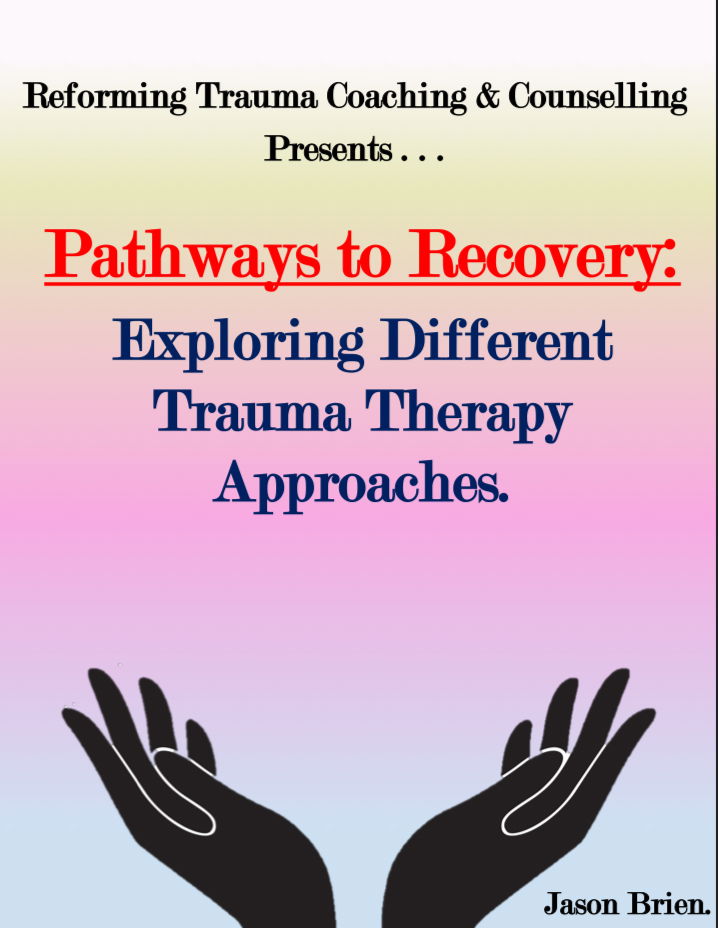Pathways to Recovery: Exploring Different Trauma Therapy Approaches.

HOW TO ORDER?
Once payment has been made through one of the below payment methods, please email me a screenshot or image of the payment receipt - reformingtraumacoaching@yahoo.com
I will reply back to your email with an attached PDF copy of your purchase order within 7 days (168 hours) of receiving the payment receipt.
If you choose to purchase multiple e-books, please specify in your email which e-books you would like to purchase.
The screenshot or image of your payment receipt should reflect your purchase order. For example, if the payment receipt only shows a payment for 100PHP or $3AUD, and you request two e-books, I will email you to clarify which single e-book you would like to purchase or to clarify if you will make an additional payment for the subsequent e-book/s.
EXTREMELY IMPORTANT: If you are waiting for an email from Reforming Trauma Coaching & Counselling, please check your junk/spam folders regularly.
HOW TO MAKE PAYMENT?
All PDF e-book's are 100PHP or $3AUD each depending on the country you reside in.
Philippines - 100PHP
GCash:
Account Name: Analiza Mose.
Account Number: 09638228024
Paymaya:
Account Name: Analiza Mose
Account Number: 09638228024
Bank of Philippine Island (BPI):
Account Name: Analiza M. Mose
Account Number: 1439132791
Australia -$3AUD (To be paid in AUD currency).
PayPal: https://paypal.me/reformingtraumacoach?country.x=AU&locale.x=en_AU
Bank-to-Bank Transfer or Osko:
Bank Name: Westpac Bank.
Account Name: Jason Brien.
BSB: 734292
Account Number: 654681
Payid:
Name: Jason Brien
Mobile Number: 0400 546 129
International Countries - $3AUD (To be paid in AUD currency).
PayPal:
https://paypal.me/reformingtraumacoach?country.x=AU&locale.x=en_AU
Western Union or Bank-to-Bank transfer:
Bank Name: Westpac Bank.
Account Name: Jason Brien.
BSB: 734292 - SWIFT code: WPACAU2S
Account Number: 654681
Street Address: 15 Housman Place,
City; Calamvale, QLD, Australia,
Postcode: 4116
Phone number: +61 400 546 129
Pathways to Recovery: Exploring Different Trauma Therapy Approaches - 8 Chapters - 163 pages.
Chapter 1: Understanding Trauma.
-Definition of Trauma.
-The Broad Spectrum of Traumatic Experience.
-Trauma as Deeply Subjective and Individualized Phenomenon.
-The Pervasiveness of Trauma.
-The Cumulative Effect of Chronic Trauma.
-Historical Perspective on Trauma.
-Types and Forms of Trauma.
-What is the Difference between PTSD and Trauma?
-Developmental and Intergenerational Aspects of Trauma.
-Neurobiological Underpinning of Trauma.
-Psychosocial Impact of Trauma.
-Recognizing Trauma Across Cultures.
-Trauma as a Precursor to Mental Health Disorders.
-Conclusion.
-Chapter 1 References.
Chapter 2: Trauma-Focused Cognitive Behavior Therapy (TF-CBT).
-Introduction to TF-CBT.
-The Cognitive Model in the Context of Trauma.
-The Importance of Incorporating Safety and Trust.
-How Effective is TF-CBT?
-Challenges and Limitations of TF-CBT.
-TF-CBT Therapy Techniques and Interventions.
-Conclusion.
-Chapter 2 References.
Chapter 3: Dialectical Behavior Therapy (DBT).
-Introduction.
-Understanding DBT: A Synthesis of Opposites.
-The 4 Core Components of DBT.
-DBT in Action: Addressing Trauma.
-DBT Group Therapy: A Community of Healing.
-How Effective is DBT?
-Challenges, Considerations and Limitations of DBT.
-DBT Therapy Techniques and Interventions.
-Conclusion.
-Chapter 3 References.
Chapter 4: Exposure Therapy.
-Introduction.
-The 3 Different Types of Exposure Therapy.
-12 Structured Steps of Exposure Therapy.
-The Importance of Safety and Pacing in exposure Therapy.
-How Effective is Exposure Therapy?
-Challenges and Limitations of Exposure Therapy.
-Exposure Therapy Techniques and Interventions.
-Conclusion.
-Chapter 4 References.
Chapter 5: Eye Movement Desensitization & Reprocessing (EMDR).
-Introduction.
-EMDR: A Journey Through the Eyes and Mind.
-8 Key Phases of EMDR.
-How Does EMDR Work?
-How Effective is EMDR?
-Challenges, Considerations and Limitations EMDR.
-EMDR Techniques and Interventions.
-Conclusion.
-Chapter 5 References.
Chapter 6: Gestalt Therapy.
-Introduction.
-Gestalt Therapy: An Overview.
-Key Concept in Gestalt Therapy for Trauma.
-The Therapeutic Relationship in Gestalt Therapy.
-How Effective is Gestalt Therapy?
-Challenges and Limitations Gestalt Therapy.
-Gestalt Therapy Techniques and Interventions.
-Conclusion.
-Chapter 6 References.
Chapter 7: Cognitive Processing Therapy (CPT).
-Introduction.
-The Foundations of Cognitive Processing Therapy.
-The Phases of Cognitive Processing Therapy.
-How Effective is CPT?
-Challenges and Considerations CPT.
-CPT Techniques and Interventions.
-Conclusion.
-Chapter 7 References.
Chapter 8: Mindfulness-Based Stress Reduction (MBSR).
-Introduction.
-The Principles of Mindfulness.
-Benefits of MBSR for Trauma Survivors.
-Adapting MBSR for Trauma.
-How Effective is MBSR?
-Mindfulness Practices in Trauma Healing.
-Conclusion.
-Chapter 8 References.
Worksheets:
-Learning Trauma-Focused Cognitive Behavior Therapy (TF-CBT).
-Learning Dialectical Behavior Therapy (DBT)
-Learning Exposure Therapy.
-Learning Eye Movement Desensitization and Reprocessing (EMDR).
-Learning Gestalt Therapy.
-Learning Cognitive Processing Therapy (CPT).
-Learning Mindfulness-Based stress Reduction (MBSR).